April 2019 started cold and wintry in this area, with morning frosts, and snow down to low levels, but warmed up considerably by mid month, with record high Easter temperatures, before ending with a more changeable feel - so given that 'mixed bag' of weather conditions, my advice for any prospective April visitors would always be "be prepared for anything and everything"!
The days really are lengthening nicely now, with around 14 hours of usable daylight, but dawn (for the Black Grouse lek) is now a slightly less sociable 5am, so if this species is on your 'wish-list', be prepared for an early start...
Although many of the winter visiting birds had departed by the second week, the influx of summer migrant birds north into this area from mid-month helped bird species day-lists creep ever higher, with 50+ species not uncommon on a full day local safari, or considerably more if you include a visit to the nearby Moray coast, whilst full day mammal species day-lists regularly crept up towards double figures, with early starts usually providing best results for the shyer ones.
I was away for the middle third of the month, so my local sightings report will be a little shorter than usual and may include a few photos from previous April safaris that are representative of the month.
 |
| A lovely spring morning at a beautiful local loch |
To give you an idea of what you may realistically hope to see if you are planning a future
April visit yourself, I hope the following more detailed information, illustrated with photos taken in and around the Cairngorms National Park and nearby Moray coast, by myself , my friends or my safari clients will help - clicking on the picture will enlarge it to full screen.
Local speciality and upland bird species seen regularly throughout the month included:
Black Grouse (at dawn only), Red Grouse, Osprey, Ring Ouzel, Slavonian Grebe, Red-Throated Diver, Black-Throated Diver, Dipper, and Goldeneye, with just a couple of brief glimpses of Crossbills.
Capercaillie, despite numerous walks in suitable forest habitat ,sadly, proved to be very elusive, and It should also be noted that, due to their very secretive nature at this time , Crested Tits also become extremely difficult to see during breeding season (April-May), and we struggled to see them this month..
Snow Buntings were seen at low level sites early in the month, but seemed to retreat high up to the mountain tops, as the snow line receded...where Ptarmigan were also reported ....
Winter visiting birds were represented by a few remaining family groups of Whooper Swans, flocks of Greylag Geese, wildfowl such as Wigeon and Teal, and a few Redwings , Fieldfares, Redpolls and Bramblings lingered, but had mostly departed by mid-month...
Summer migrant birds flooded in from mid-month on the warm southerly winds, with our first sightings this year of Common Sandpiper, Sand Martin, House Martin, Swallow, Willow Warbler, Chiffchaff, Wood Warbler, Wheatear and Tree Pipit to name just a few...
Mammals seen regularly by my safari parties during the month included:
Red Squirrel, Roe Deer, Red Deer, Reindeer, Feral Mountain Goat (with youngsters), Rabbit, Brown Hare and Mountain Hare (now a mottled blue-grey).......with just a couple of sightings of Sika Deer....
April 2019 bird sightings in more detail:
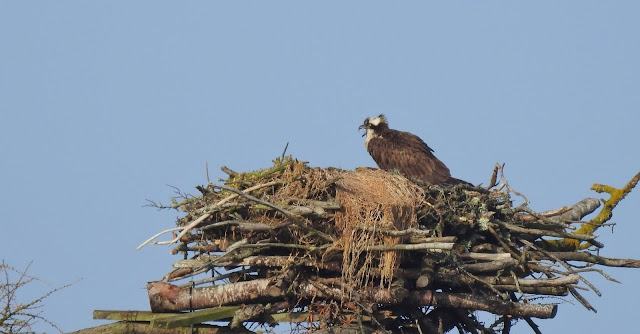 |
| Osprey |
One of my favourite wildlife moments every year, is the return of our local Ospreys to their nesting sites. These impressive birds of prey are always popular with my safari clients, with their dashing good looks, large size, aerial acrobatics and spectacular plunge diving to catch fish. Many of our local pairs were reunited by mid-month after a winter apart in West Africa, and were soon seen building up their nests, chasing off intruders and mating frequently, and by the very end of the month some of the hen birds appeared to be incubating eggs as the cock birds began to perform all of the fishing duties, whilst the females stoically brooded the eggs despite the sometimes inclement weather.
 |
| Choose me! Choose me! Cock Black Grouse compete for a hen's affections... |
April is definitely THE month to see Black Grouse, and dawn (now around 5am) visits to local Black Grouse leks continued to delight and amaze my safari clients with as many as 11 blue-black cock birds seen 'performing' in spectacularly aggressive fashion, their incredible bubbling and whooshing sounds drifting across the moor, and on a couple of occasions late in the month, we were very lucky to witness the hen birds walking among them ,watching the action, and presumably 'rating' the contestants, only around 20% of whom will 'get lucky', and some were even seen mating with their chosen partner - a truly fantastic wildlife spectacle and a great way to start the day!
 |
| Cock Red Grouse 'guarding' his territory |
Our local moorlands continued to echo with the characteristic cackling calls of the cock Red Grouse, many of whom were seen still actively displaying from raised positions, with red 'eyebrows' aglow, presumably 'guarding' their territory, and from mid-month we saw very few hen birds, suggesting that many may already be incubating eggs.....
With no 'rogue' birds in this area to go for these days, and numbers now confirmed to be declining to dangerously low levels, Capercaillie sightings are now much more difficult to come by, and sadly, we did not manage a single sighting this month, despite several walks in suitable Caledonian forest habitat, where we had been successful before...
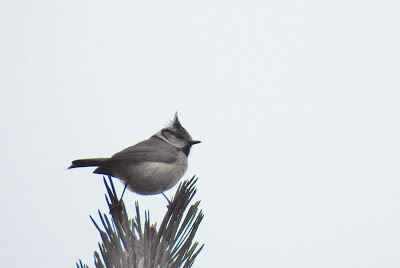 |
| Crested Tit |
Still in the forests, Crested Tit sightings too were hard to obtain this month, with one or two birds seen early on using forest feeding stations during the colder weather, but generally they were pretty elusive, seemingly quietly going about their business breeding.....and I should point out that you really need to be familiar with their 'chuckling trill' of a song to have a realistic chance of seeing them...
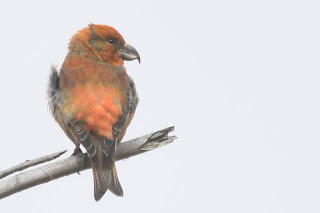 |
| Male Crossbill by Steve Nicklin |
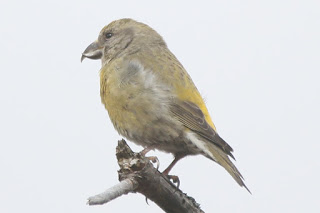 |
| Female Crossbill by Steve Nicklin |
Still in the forests, sadly, it was the same old story with our Crossbill sightings , most of which were of the rather annoying fly-over variety again this month, though those of us quick enough with our binoculars, and alerted to them by their distinctive 'jip' 'jip' calls, saw enough to suggest that we were seeing family groups of streakily marked youngsters with their parents....though top local birder and photographer Steve Nicklin seems to have the knack with them that I clearly lack!!!
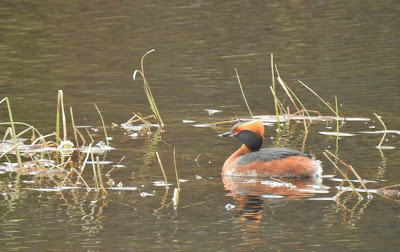 |
| Slavonian (Horned) Grebe |
 |
| Red - Throated Diver by Steve Nicklin |
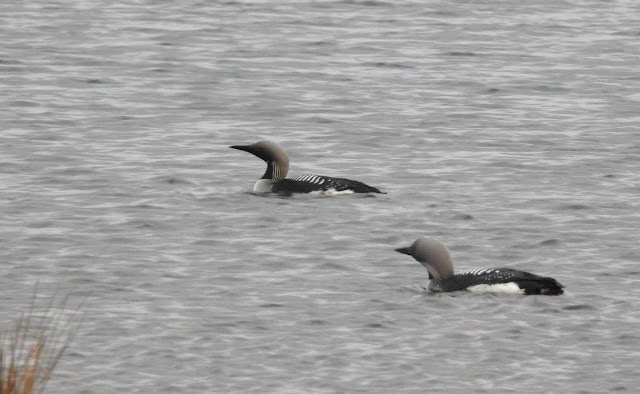 |
| Black - Throated Divers |
Now the local lochs are no longer in danger of freezing over, some of our local speciality water birds are back on their summer breeding territories, and we managed to see some of the most attractive and rare examples regularly this month - namely Slavonian (Horned) Grebe, Red-Throated Diver and Black-Throated Diver, all in their splendid summer plumage.
 |
| A pair of Goldeneye |
Also on the lochs (and rivers), we must not forget our breeding Goldeneye population , and we were fortunate enough to see them regularly this month, with many of the dapper males still performing their unique and spectacular 'head-banging' mating display!
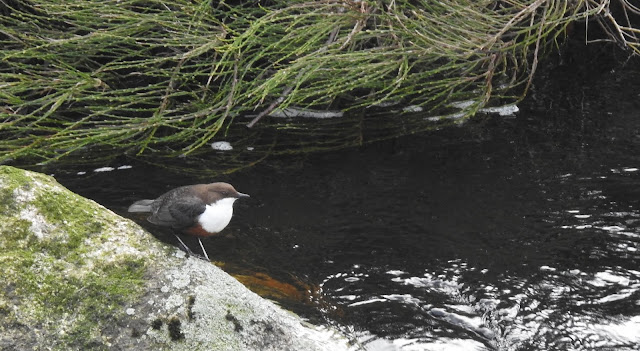 |
| Dipper |
On the rivers, it was noticeable that there were increased occurrences of male Dippers seemingly delivering food to the now well hidden female birds at their nest sites , usually under bridges or under high , overhanging banks...and we also witnessed a few instances of rival males fighting over territory...
 |
| Snow Bunting |
Up in the mountains, as I mentioned earlier, although I did not make a trip up to the the tops myself this month - the Cairngorm Funicular railway is still out of action - visits to the ski centre car park early in the month when the snow was down to lower levels gave good views of a few lingering Snow Buntings, and those that did walk up reported some decent sightings of Ptarmigan as well, with both species now morphing into their summer plumage...
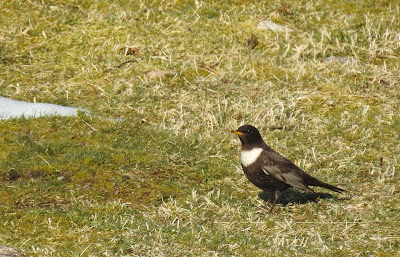 |
| Male Ring Ouzel |
At slightly lower levels, Ring Ouzels proved to be popular with my safari clients, presumably because not many will have seen them, as they tend to breed only in remote upland areas well away from human disturbance, and can be quite tricky to find. We are fortunate in having plenty of suitable habitat for them in this area though, and we were able to get decent views and photographs of both male and female birds on a number of occasions.
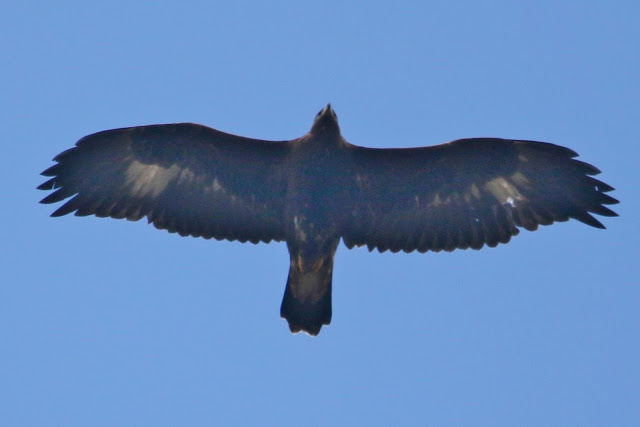 |
| Golden Eagle by Steve Nicklin |
 |
| Goshawk by Steve Nicklin |
 |
| Sparrowhawk |
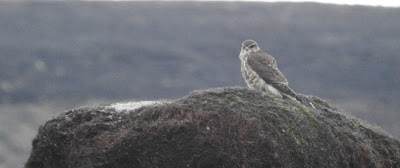 |
| Merlin |
Up in the local glens, bird of prey sightings usually become less frequent during the longer days of spring and early summer, with many of the female birds now nesting and many more hours of daylight available for hunting, and so it proved this month. However, we still managed reasonably regular sightings of Osprey, Common Buzzard, Red Kite, Peregrine, Kestrel and Sparrowhawk, just a few views of Goshawk, Golden Eagle and White-Tailed Eagle, and one decent view of a Merlin...
Other good or rare birds seen or reported locally this month included:
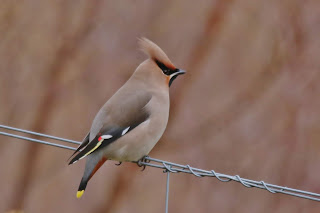 |
| Waxwing by Steve Nicklin |
 |
| Whooper Swans by Steve Nicklin |
Waxwing , Brambling, Whooper Swan ( early in the month only), Great Grey Shrike, Tree Sparrow, Mandarin Duck, Golden Pheasant, and a Northern Long-Tailed Tit ....
 |
| Dawn at a local moorland loch |
Moray Coast highlights:
The Moray coast is only about a one hour drive north of Aviemore, and although I did not have time to make a trip there myself this month, I see from reports that my favourite reserves, lochs, bays and harbours gave good views of birds such as Greylag Geese, Pink-Footed Geese, Brent Geese, Whooper Swan, Eider, Wigeon, Teal, Scaup, Pintail, Bar-Tailed Godwit, Black-Tailed Godwit, Knot, Golden Plover, Ringed Plover, Purple Sandpiper, Common Scoter, Velvet Scoter, Red-Throated Diver, Black-Throated Diver, Great Northern Diver, Guillemot, Goosander, Red-Breasted Merganser, and Long-Tailed Ducks....though not in the numbers seen last month....as most of the birds are presumably now drifting off to their breeding grounds...though to offset this, summer-visiting birds such as Gannet, Fulmar, Kittiwake, Osprey and various Auk species began to be seen...
April 2019 mammal sightings in more detail:
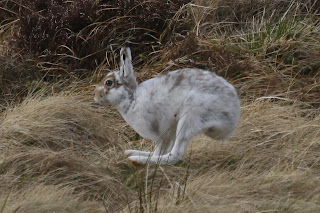 |
| Spring Mountain Hare by Steve Nicklin |
Despite now being in their mottled white and blue-grey spring outfits, Mountain Hares still proved to be the one to beat in our 'mammal of the day' awards, though they certainly became tricky to find among the mottled white and blue-grey rocks of their upland homes!!
 |
| Red Deer stags |
Red Deer too, always prove popular with my safari clients. Being an iconic animal of the Scottish Highlands, the 'Monarch of the Glen' is on most visitors 'wish-lists', and we managed to see them regularly in large same-sex herds in upland glens this month, though many of the stags are now losing their antlers....
 |
| Feral Mountain Goats |
Feral Mountain Goats are only found in a few remote upland areas of the UK, and we were lucky enough to have lots of good views of these wild looking, multi-coloured creatures this month, with some of their rapidly growing youngsters .....
 |
| Red Squirrel |
Red Squirrels always prove to be popular with my safari clients, especially those seeing them for the first time, and we were fortunate enough to see them on all but one of my safaris this month, mostly at feeding stations, with just the occasional one seen up in the trees whilst on a forest walk...
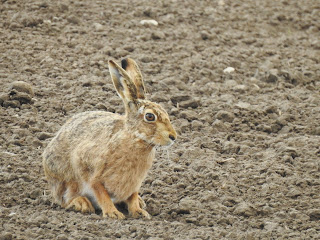 |
| Brown Hare |
Our local Brown Hares seemed to be very 'frisky' this month, and our early starts produced some great views of these usually very timid and secretive animals...
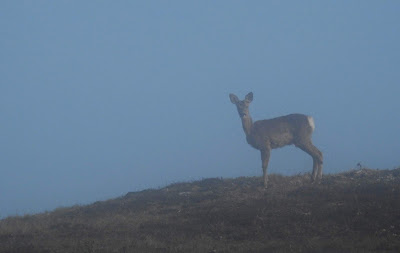 |
| Roe Deer |
Similarly, good numbers of Roe Deer were seen soon after dawn on most of my safaris this month, though getting a decent photo is often tricky in the low light levels....
We also saw our first few brave Butterflies this month, Peacocks, Small Tortoiseshell and Orange Tip among others, as well as numerous Frogs and Toads ......
 |
| Enjoying our picnic lunch at a picturesque local upland glen |
Summary:
It is only when I finally find time to sit down and compile my monthly wildlife sightings blog and look back through my sightings notes and the photos that I and my safari clients have taken during the month that I really become aware of what a great time I have had, appreciate how lucky I am to live and work in such a wild and beautiful place and spend time out and about sharing it with other like-minded wildlife fans from around the world, .... and it would appear that April 2019, despite the sometimes changeable weather, turned out to be a really excellent and very enjoyable month for wildlife watching in and around the Cairngorms National Park (and beyond!), With the local speciality birds displaying and singing, the returning summer visiting birds flooding northwards to join our resident species, the days lengthening, flowers blooming, butterflies and Bees on the wing , the stunning scenery - especially at dawn - and the weather (generally! ) improving, I can honestly say that I would not want to be anywhere else in the world than here in the majestic Scottish Highlands at this time of year....
I know a lot of visitors to this area very wisely check out reviews of attractions at tripadvisor before 'taking the plunge' and booking - if you wish, you can check out my clients comments at the link below....Many thanks to all those that have made the effort to post me a review..... just cut and paste it into your web browser...
https://www.tripadvisor.co.uk/Attraction_Review-g186537-d3335134-Reviews-Highland_Wildlife_Birdwatch_Safaris-Aviemore_Aviemore_and_the_Cairngorms_Scottish.html
If you think you know someone who may enjoy a taste of what I do, why not treat them to a safari gift certificate. They make a thoughtful and imaginative present, are available for any amount and are valid at any time within a year from date of purchase....








